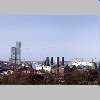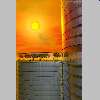|
You can almost
hear Le Corbusier sigh with relief from here, the death of the
Modernist Movement in architecture has been greatly exagerated.
Whilst it's
true that the 70s and 80s saw great housing projects fall into
disrepute as Thatcherite budget cuts ruthlessly attacked the funding
and ultimately quality of council estates, the current property
increases, which in some parts of the country show no sign of
stopping, once more show the need for cheaper and more affordable
housing. Given that housing like all commodities has it's price
linked to supply and demand the only way to drive down property
prices and create new areas of housing which are cheap and available
to all is to build again.
The existence
of the Barbican has showed that well managed and funded tall residential
buildings can work and that the "tower-block experience"
that led to the high-rise being so reviled was down to poor quality
materials and lack of money for maintenance as well as ghettoising
the building with poor residents. Times have changed and as the
new century starts there is increased confidence in the residential
highrise. Futuristic architects David Marks and Julia Barfield
have come up with what they think is the solution to the housing
crisis - Skyhouse.
 An
artists impression taking a look up from near the base of
skyhouse. An
artists impression taking a look up from near the base of
skyhouse. |
 A
real world view of how Skyhouse could look on the edge of
the Isle Of Dogs. A
real world view of how Skyhouse could look on the edge of
the Isle Of Dogs. |
Like Le Corbusier's
L'Unite d'Habitation and his grand plan for Paris Marks and Barfield
intially envisaged Skyhouses with 50 floors of residential space
laid out on the Greenwich peninsula surrounded by acres of parkland.
In a new take on the Garden City movement they included designs
for four levels of double floored gardens inside the tower,
a novel idea at the time but one which is finding increasing popularity
with other green architects now. Despite solving much of the housing
problem of the area the project simply wasn't commercial enough
and the redevelopment was passed on to more lucrative bidders.
When they
returned they brought with them a brand new Skyhouse. With ten
residential floors lopped off each wing it made a much more realistic
proposition than the previous design which would have towered
over pretty much everything in London and was perhaps too radical
in height. Weighing in at just over 620ft/189m this design was
much more realistic and thanks to it's reduced height would not
look out of place in Canary Wharf which is exactly where they
are looking now.
However since
the failure of their plan to bring a dozen Skyhouses to Greenwich
there has been the problem of a lack of a suitable site to build
on. Unlike other architects who work to commission Marks and Barfield
freelance coming up with an idea and then approaching many different
companies to try and win backing, both financial and logistical.
It was this approach that eventually saw the construction of the
London Eye and it is one they are trying again with Skyhouse.
 A
close up of a sky garden and visiting residents at sunset. A
close up of a sky garden and visiting residents at sunset. |
 Movie
(2.83.mb). Movie
(2.83.mb).
A short visual tour of skyhouse. 45 secs. Requires the div-x
codec to view. |
The redesign
of Skyhouse though has seen a media relaunch, and like all good
ideas the media seem to be very interested in it. As the housing
shortage reaches it's peak (or perhaps nadir would be more appropiate),
the relaunch has attracted increased interest from potential backers.
A number of sites have been identified all over the U.K, although
outside London it remains to be seen whether it is feasible to
construct such a large building and respect the surroundings.
The Isle of Dogs which already has Canary Wharf there, is the
main focus though for development and contains over a dozen potentially
suitable sites.
With the architects confident that they will have a site, the
only thing holding them back from construction is the lack of
a developer however it's likely that once a site has been secured
a number of developers will come forward with much interest.
The only catch
is that Marks and Barfield imagine Skyhouse to be a place for
ordinary people to live and work, with flats starting at a very
reasonable for London £75,000. With this insistence to have
a large amount of affordable housing within, there are much lower
profits than normal to be made for a developer which is part of
the reason things have taken so long to get off the ground. To
further complicate things Tower Hamlets council believe that such
projects are not suitable as council housing and prefer to move
their tenants to Newcastle(!)
Architect
David Marks remains confident though that not only will the first
site be secured but also funding and that by the end of 2004 the
first Skyhouse will have progressed through the planning system
and construction will be underway. If the first building is a
success, and there is no reason to doubt it won't be, we can expect
anything up to half a dozen other Skyhouses to be built in suitable
sites across London over the last half of the decade.
Given the
scale of the housing problem no-one is under any illusions that
Skyhouse is the only solution - to solve that problem will require
much more radical ideas than just building some skyscrapers in
London. It will at least provide thousands of much needed homes
on brownfield sites and if positioned correctly, welcome additions
to the London Skyline.
|